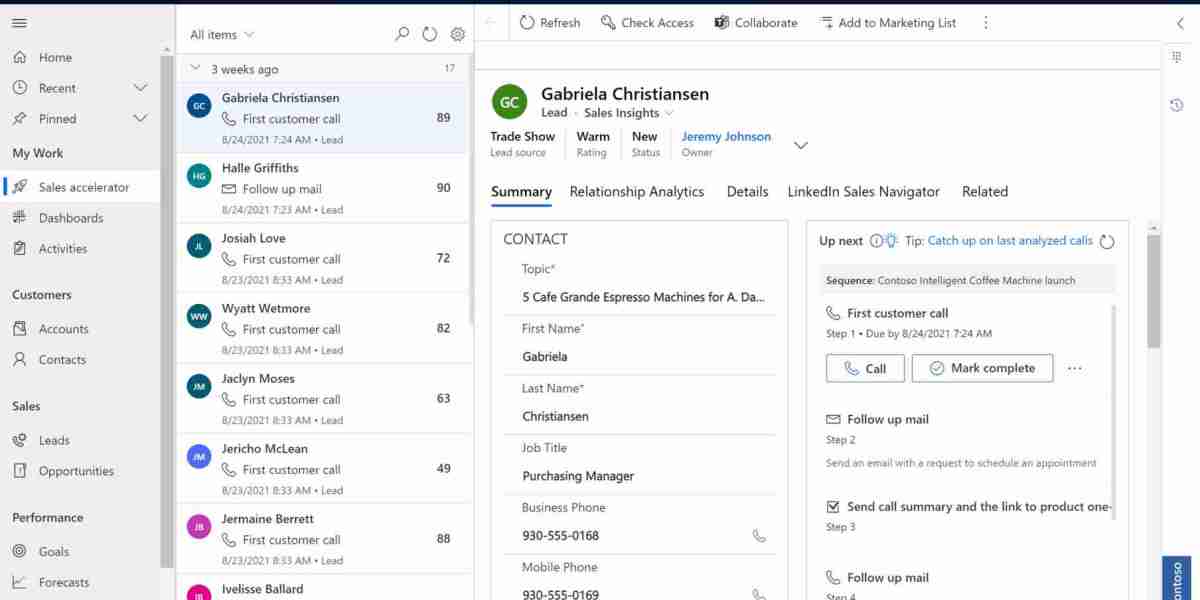In today's competitive business landscape, choosing the right Customer Relationship Management (CRM) software is crucial for driving sales, enhancing customer experiences, and optimizing business operations. Two of the most popular CRM platforms, Microsoft Dynamics 365 Sales and Salesforce, dominate the market. Both offer robust features, advanced automation, and powerful integrations. But which one is the right fit for your organization? In this detailed comparison, we break down their features, pricing, scalability, and key benefits to help you make an informed decision.
Feature Comparison: Dynamics 365 Sales vs. Salesforce
1. User Interface and Ease of Use
Microsoft Dynamics 365 Sales: Offers a seamless and intuitive interface, especially for organizations already using Microsoft products like Office 365, Outlook, and Teams. The familiar UI reduces the learning curve for employees and enhances productivity.
Salesforce: Known for its highly customizable interface, Salesforce allows users to tailor the CRM to their specific needs. However, the extensive customization options can be overwhelming for new users, requiring additional training.
2. Sales Automation and AI Capabilities
Dynamics 365 Sales: Leverages AI-driven insights, predictive analytics, and automation through Sales Insights. This helps sales teams prioritize leads, analyze customer sentiment, and automate repetitive tasks.
Salesforce: Features Salesforce Einstein AI, which offers advanced forecasting, lead scoring, and automated workflows. It provides intelligent recommendations but often requires additional setup and configuration.
3. Integration with Other Business Applications
Dynamics 365 Sales: Seamlessly integrates with the entire Microsoft ecosystem, including Power BI, Azure, SharePoint, and Teams. This makes it a strong choice for businesses already invested in Microsoft solutions.
Salesforce: Offers integrations with a vast number of third-party applications via AppExchange. While powerful, integrating Salesforce with Microsoft applications requires additional connectors and customization.
4. Customization and Scalability
Dynamics 365 Sales: Provides deep customization through Power Platform (Power Automate, Power Apps, and Power BI). Users can build custom applications and automate workflows without extensive coding. Microsoft Dynamics 365 Sales Solutions
Salesforce: Offers robust customization options through Apex (its proprietary programming language) and Lightning App Builder. While powerful, extensive customization often requires dedicated developers.
5. Pricing and Cost Considerations
Dynamics 365 Sales: Pricing starts at $65 per user/month for the basic plan, with higher-tier plans offering more advanced features. It provides better value for organizations already using Microsoft 365.
Salesforce: Starts at $25 per user/month (Essentials plan), but to access full CRM capabilities, businesses need to opt for higher-tier plans (Enterprise at $150 per user/month). Additional costs for integrations and customization can quickly add up.
6. Customer Support and Community
Dynamics 365 Sales: Backed by Microsoft’s extensive support network, Dynamics 365 offers multiple support channels, including documentation, community forums, and dedicated customer service.
Salesforce: Provides strong support options, including Trailhead (an interactive learning platform), community forums, and premium support services for enterprise customers.
Key Benefits of Microsoft Dynamics 365 Sales
1. Seamless Microsoft Ecosystem Integration
For organizations already using Microsoft products, Dynamics 365 Sales provides native integration, ensuring better collaboration, data synchronization, and unified reporting.
2. AI-Powered Insights for Smarter Selling
With AI-driven insights, real-time forecasting, and customer sentiment analysis, Dynamics 365 Sales empowers sales teams to make informed decisions.
3. Lower Total Cost of Ownership (TCO)
Compared to Salesforce, Dynamics 365 Sales offers a more affordable pricing structure with flexible plans tailored to different business needs.
4. Built-in Business Intelligence
Leverage Power BI for advanced analytics, interactive dashboards, and data-driven decision-making without needing third-party tools.
Key Benefits of Salesforce
1. Extensive Third-Party Integrations
Salesforce’s AppExchange marketplace offers thousands of third-party integrations, making it a versatile CRM for businesses that rely on multiple applications.
2. Highly Customizable Platform
With Apex programming and Lightning App Builder, organizations can create tailor-made CRM solutions that fit their specific business processes.
3. Large and Active Community
Salesforce boasts one of the largest CRM communities, providing businesses with valuable resources, training, and expert support.
Which CRM Should You Choose?
Choose Microsoft Dynamics 365 Sales if:
✅ Your business already uses Microsoft 365, Outlook, Teams, or Azure
✅ You need deep integration with Microsoft tools and seamless collaboration
✅ You want affordable pricing with AI-powered insights
✅ You prefer low-code/no-code customization via Power Platform
Choose Salesforce if:
✅ You require extensive third-party integrations and a wide range of add-ons
✅ Your business needs highly customizable CRM capabilities with Apex programming
✅ You have a dedicated team for CRM configuration and development
✅ You prioritize a large community with extensive training resources
Final Verdict
Both Microsoft Dynamics 365 Sales and Salesforce are industry-leading CRMs with powerful features. However, the right choice depends on your business’s existing technology stack, budget, and customization needs. If your organization is already invested in Microsoft products and needs a cost-effective, AI-powered, and deeply integrated CRM, Dynamics 365 Sales is the superior choice. However, if your business demands extensive third-party integrations, advanced customization, and a large community support system, Salesforce may be the better fit.
Whichever CRM you choose, investing in a robust CRM solution is key to enhancing customer relationships, improving sales performance, and driving business growth.




